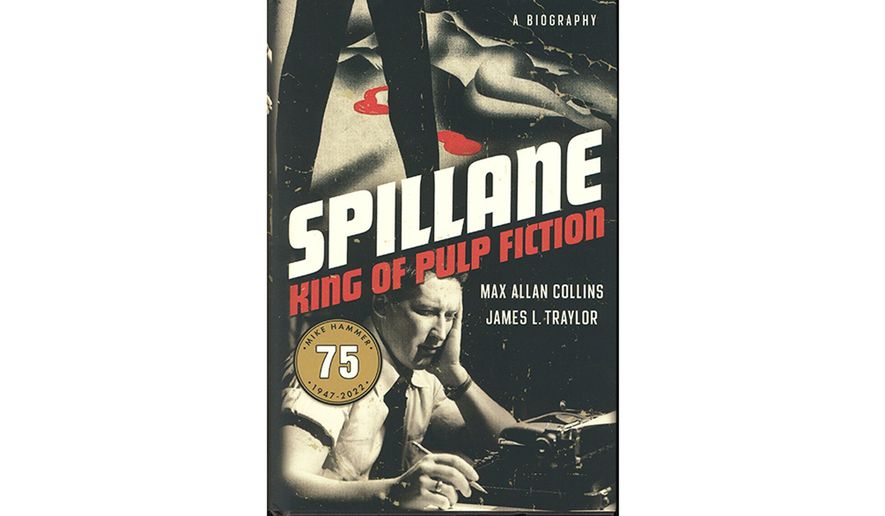OPINION:
In my last On Crime column, I interviewed Max Allan Collins, the co-author of “Spillane: The King of Pulp Fiction,” a fine biography of the late crime writer Mickey Spillane.
Spillane, who died in 2006 at the age of 88, wrote the Mike Hammer crime novels and other crime thrillers. Although he received some of the worst book reviews ever written, his novels were bestsellers. As I noted in my previous column, Spillane was unabashedly conservative and unpretentious. He was also self-deprecating about his work, calling his novels “the chewing gum of American literature.”
He later became as famous for mocking his tough-guy image in beer commercials on TV as he was for his novels.
The late Raymond Chandler, one of my favorite writers, dismissed Spillane, having his iconic private detective character Philip Marlowe drop what he noted passed for a crime novel in a trash can — as no garbage can was available.
Another of my favorite writers, Elmore Leonard, felt differently about Spillane. Writing in Time magazine after Spillane’s death in 2006, Leonard wrote: “I remember when ’I, The Jury,’ Mickey Spillane’s first novel, came out in 1947. I was in college and had just come out of the service the summer before. Forceful and full of energy (it had to have been, since he wrote it in nine days), the book knocked me out.
“In 1995, as president of the Mystery Writers of America, I had the privilege of honoring Mickey with the title of Grand Master, despite some members’ objections. Whether you liked him or not, he played a key role in the development of crime fiction — I’m not sure phrases like “Hot damn!” were ever popular before he used them, and shooting a girl in the navel in “I, The Jury”? That’s as good as it gets.”
I contacted the other co-author of “Spillane: King of Pulp Fiction,” James L. Traylor and asked him why he co-wrote a biography of Mickey Spillane.
“The reading public’s knowledge of Spillane — biographical or otherwise — was limited to press releases, the entertaining but not very informative interviews that Mickey freely gave or the Life magazine article dating from 1952. We wanted to tell the most interesting story, which was his life,” Mr. Traylor replied.
“Spillane’s influence was generational. He helped shape three generations of mystery and thriller writers. And the influence did not stop with fiction, but crossed over to film and TV, leading to the PI era of the late 1950s, and eventually to the success of Tarantino’s ’Pulp Fiction’ and the current TV series incarnation of ’Reacher,’” Mr. Traylor said. “Spillane was a master of the fast-paced turn-the-page thriller. His narrative thrust forced the reader to continue as quickly as possible to the punch ending, they knew awaited them. All the early paperback novels had this on the cover: ’A Mike Hammer Thriller.’”
Mr. Traylor was nominated for the Mystery Writers of America’s Edgar Award in 1985 for “One Lonely Night: Mickey Spillane’s Mike Hammer” (co-written with Max Allan Collins), and he and Mr. Collins co-wrote “Mickey Spillane on Screen.” Like many others, Mr. Traylor said he was influenced by Spillane.
“I was captured by his simplicity of style which propelled the action at breakneck speed. I have tried to put this leaner style into everything I write — whether fiction or nonfiction,” Mr. Traylor explained. “Spillane was a pleasure to know. Being in his company was an adventure, his personality dynamic always moving. Indeed, keeping up with him was like following a doctor making rounds in a hospital — if you did not pay close attention, he was gone … on to the next case.”
I asked Mr. Traylor what he said to those who dismiss Spillane as a writer.
“Usually, those who dismiss Spillane have never read him. His unique talent helped him entrance millions of fans and readers. Everyone read him, and a large number of them wrote him letters. Seventy-five percent of the mail was from women,” Mr. Traylor said. “Future generations will read Spillane to learn how mass media in all its forms changed and grew shortly after WWII. Future mystery readers will return to ’Kiss Me Deadly’ and the other early Hammer novels as influential and prototypical examples of the form.”
• Paul Davis’ On Crime column covers true crime, crime fiction and thrillers.
• • •
Spillane: King of Pulp Fiction
Max Allan Collins and James L. Traylor
Mysterious Press, $26.95, 400 pages




Please read our comment policy before commenting.